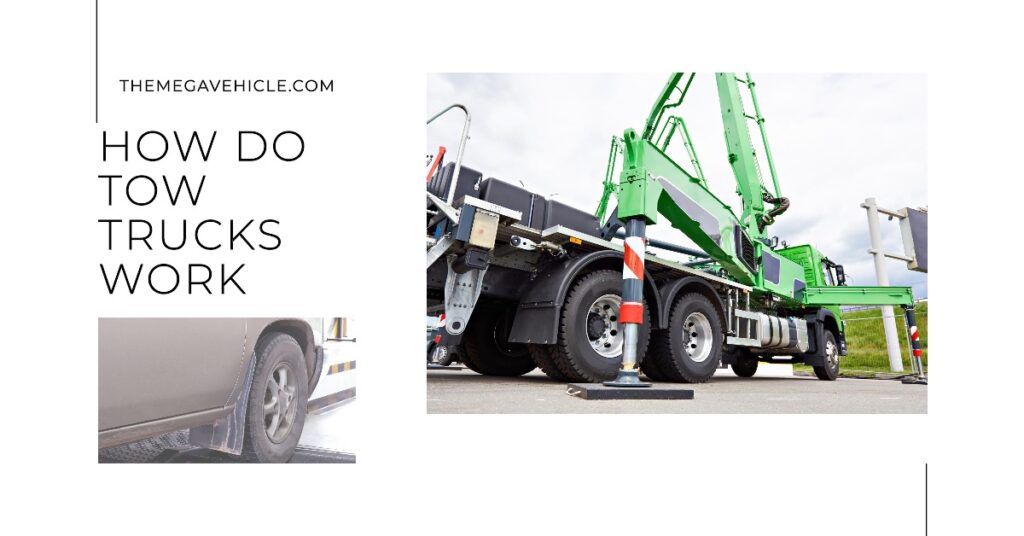Whether it’s a mechanical failure or an accident, our first instinct would be to call tow services and take the vehicle to a workshop for repairs. But have you ever wondered how do tow trucks work?
In this blog, we will discuss the mechanisms that these tow trucks use, making it easier for you to choose the next time your car needs a tow.
Tow Trucks Mechanism:
Before delving into the mechanics, it is important to familiarize yourself with the various types of tow trucks specifically designed to meet different towing needs. The standard categories include flatbed tow trucks, hook and chain tow trucks, and wheel lift tow trucks. Each type is equipped with unique features tailored to address specific scenarios.
Let’s discuss the significant towing mechanism here.
1. Hydraulic Mechanism: An Overview of Its Functionality and Applications
The hydraulic system of a tow truck plays a crucial role in its operation. It is powered by a power take-off unit that is connected to the truck’s engine. This system utilizes valves, hoses, and cylinders to generate hydraulic power and effectively control the movements of the tow truck’s various components.
2. Boom Mechanism:
Tow trucks equipped with a boom feature a long arm extending from the truck’s rear. This arm can pivot and swivel, enabling the operator to reach disabled vehicles. At the end of the boom, a hook or sling securely attaches to the disabled vehicle for towing.
3. Winch Mechanism:
First, the tow truck operator drives the tow truck close to the disabled vehicle. Next, he uses the winch to pull the disabled vehicle onto the tow truck bed. Finally, the tow truck operator drives the tow truck to the desired location.
4. Wheel-Lift Mechanism: A Revolutionary Innovation
The wheel-lift mechanism is a highly versatile towing solution. It employs a metal yoke that can be hydraulically positioned beneath the wheels of a vehicle. By lifting the vehicle by its wheels, the tow truck is able to tow it with either the front or rear wheels off the ground. This mechanism is helpful for vehicles that cannot be towed using a boom or winch.
Controls and Safety Measures:
Towing plays an integral role in many businesses, especially when it comes to moving large objects. Tow trucks are essential for this purpose and are typically equipped with multiple control panels. These panels give the operator complete control over the towing mechanism and the hydraulic system.
Additionally, tow trucks often include safety features such as safety chains or straps, warning lights and sirens, and stabilizers to ensure stability throughout the towing process.
Maintenance and Training:
Regular maintenance is essential for ensuring the optimal performance of tow trucks. This involves inspecting and servicing the hydraulic system, checking the towing mechanisms, and addressing any mechanical issues that may arise.
Tow truck operators undergo specialized training to comprehensively understand the equipment, safety procedures, and best practices involved in towing vehicles.
Conclusion:
A tow truck is a vital transportation tool that is utilized for moving disabled or improperly parked vehicles. These trucks employ hydraulic systems and a range of towing mechanisms to accommodate various towing scenarios and ensure the secure transportation of vehicles.
Understanding the inner workings of tow trucks allows us to better appreciate the technology and expertise involved in their operations.
FAQ’s
1. Can a tow truck move a car without keys?
Yes, this can be done by either lifting the drive wheels off the ground or using a flatbed truck.
2. What happens if you tow too heavy?
It is important to avoid taking such risks, as they can lead to accidents where the brakes may not work correctly, the tires could burst, or the engine may get damaged.
3. What is the difference between tow haul and tow?
Towing refers to the action of pulling one vehicle by connecting it to another. On the other hand, hauling involves transporting loads either inside a vehicle or on a trailer.

